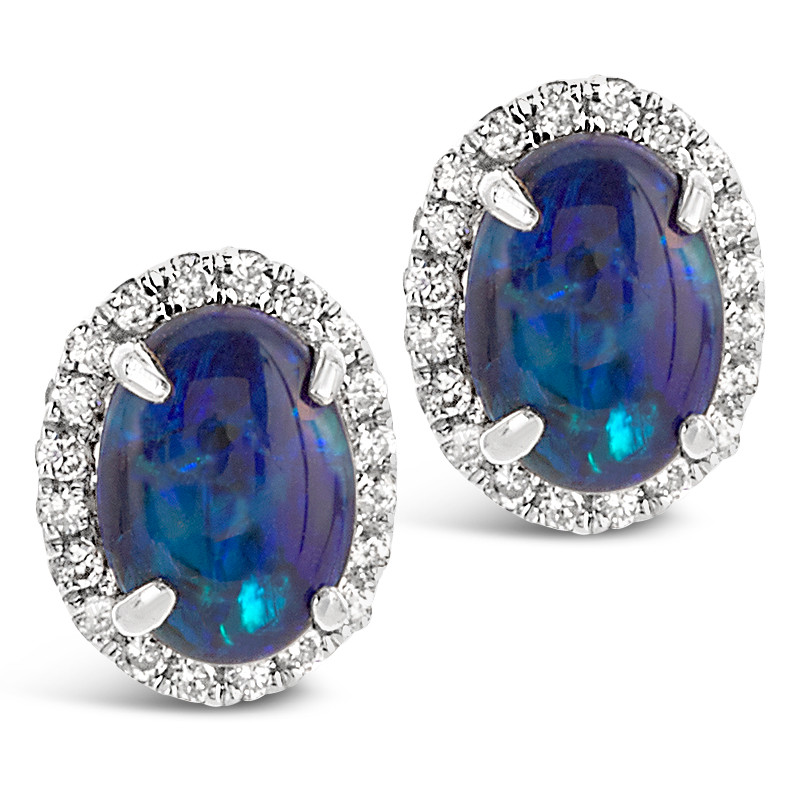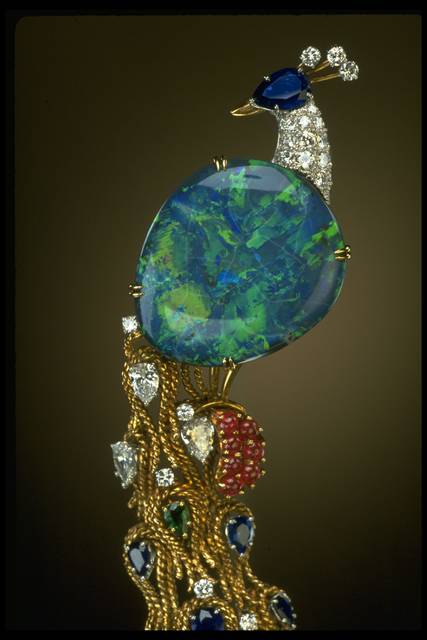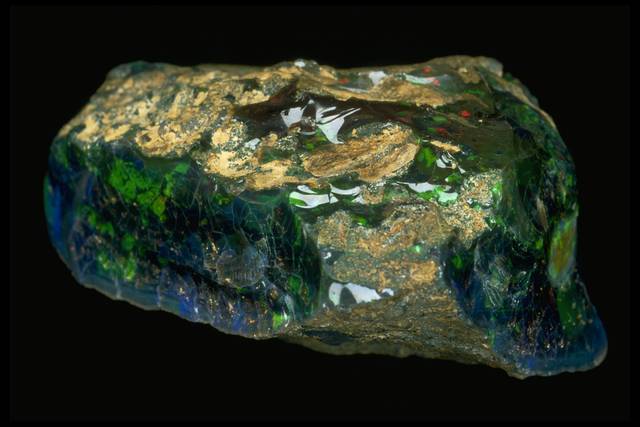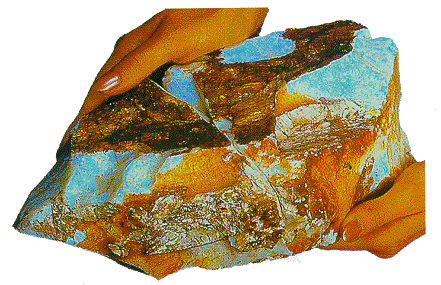October, with tourmaline and opal, is another month with more than one birthstone option. This blog provides information about electrifying opal, with its shifting play of kaleidoscopic colors. I cover October Birthstone: Tourmaline - facts and lore in a separate blog.
Opal is known for its unique ability to diffract light into an inferno of flashing colors called play-of-color. Because of this phenomenon, writers, for centuries, have compared opals to lightning, volcanoes, galaxies, and fireworks.
Play-of-color is the most spectacular and valuable aspect of an opal’s appearance. If an opal displays vivid play-of-color which envelops the stone's entire body and flashes all the spectral colors, it’s, indeed, very rare and valuable.
Opals are classified in a couple different ways. The first is based on whether or not they display play-of-color. In this classification system opals are either precious, those displaying play-of-color or common, those which do not.
Gem experts have an another way of categorizing opal using other physical characteristics of the gemstone. Unfortunately, there is no agreed upon global standard of the categories, but below I’ll present some significant ones:
- White opal – This category is distinguished by the degree of the stone’s transparency and the background color of the gem’s body; also known as body color. White opals possess a white or light gray body color, are translucent to semi-translucent and display play-of-color. White opal is the most common opal and because of its body color, generally exhibits less vibrant play-of-color than boulder opals and black opals. Nevertheless, good quality white opals can still be absolutely magnificent.
- Black opal – This category is also distinguished by the degree of transparency and background color of the gem’s body. Black opal is translucent to opaque, shows a black or other dark body color and flashes play-of-color. To reinforce, the term ‘black opal’ does not mean the stone’s background color can only be black, it simply means the stone has a dark tone, such as dark blue, gray, or black. The dark body color shows off the play of color in a manner unmatched by white opals. All other quality factors being equal, black opal is often preferred because of the brilliance of its play-of-color. Black opals are much more rare and highly prized than white opals.
- Fire opal – Fire opal’s body color is normally transparent to translucent, with a yellow, orange, or red body color and often doesn’t show play-of-color. The most valuable, although rare, are both crystal clear and intensely bright with saturated yellowish orange to orangy red color and display strong play-of-color. The most famous source of fire opals is Mexico, whose orange opals are commonly called “Mexican fire opals”.
- Boulder and matrix opal - Boulder opal, as the name suggests, is mined from boulders buried within the ground. Thin veins of colorful opal forms in cracks and fissures within the boulder’s rock. Because the veins of color are so thin, opal cutters retain part of the boulder, known as matrix, on the back of the opal. This is done to create a gemstone capable of withstanding the rigors of being mounted in jewelry. Boulder opal can be dark or light depending on the appearance of the stone when viewed from the front. Its thin layer of opal can display beautiful play-of-color showing any color of the spectrum. Boulder opal is easily distinguished by its layer of solid matrix material retained on the back.
- Crystal opal - Crystal opal is transparent to semitransparent with a clear background and shows exceptional play-of-color. It is the second most popular opal, exceeded in popularity only by black opal. Crystal opal’s body color can be either light or dark. If light is able to pass through the stone or you can see through it, then you’re probably looking at a crystal opal. However, a fine line exists between white opal and crystal opal. Sometimes there is only a mild or medium translucence which may lead to the opal being classified as either a white opal, crystal opal, or even a “white crystal opal”.
- Water opal - Water opal is normally colorless, but can also show faint tints of bluish grey, green or yellow, with a transparent to translucent gelatinous appearance similar to glass. Water opal may or may not display play-of-color. If it does show play-of-color, it is faint and covers only small portions of the gem. The most notable sources of water opal are Mexico, Australia and the US state of Oregon.
Opal is also the stone given to celebrate the 14th wedding anniversary.
I haven't personally designed any opal jewelry pieces. Instead, I decided to rely on a true opal expert to help with that. At an AGTA GemFair, I had the opportunity to meet John Ford, an award winning jewelry designer who specializes in black opals from Australia’s famed Lightning Ridge mine. I wanted to offer opals on my site and took the decided to occasionally offer some of John's pieces. Click the link to browse the current 100 East Fine Jewelry Opal Collection. The initial opal jewelry item I acquired from John's collection was the following pair of earrings:
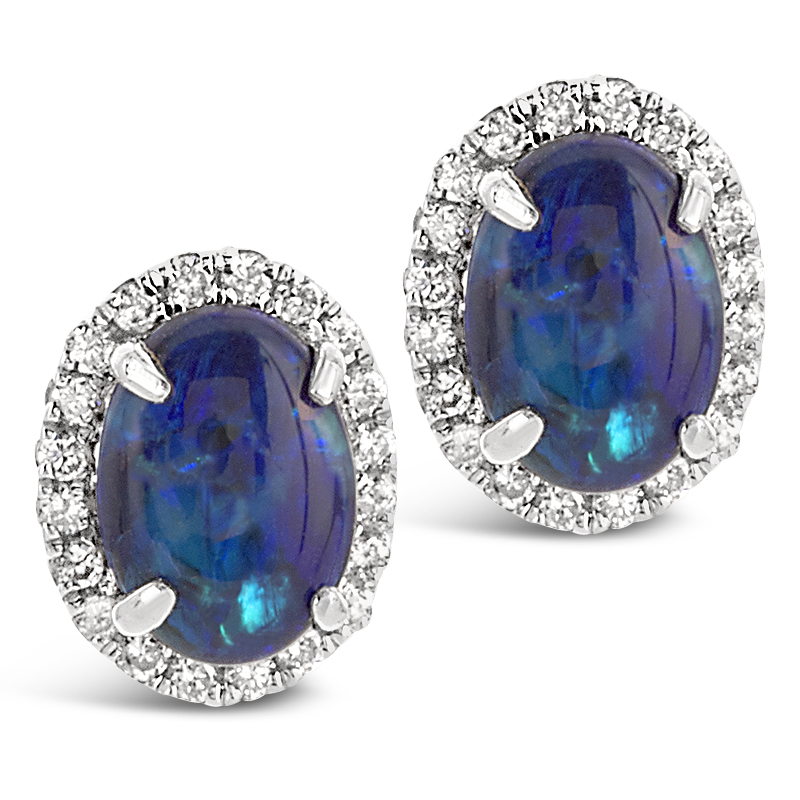
I also acquired a matched set of Mexican fire opal gemstones, for which I haven’t yet decided on a design, but you can pretty certain they will be used in earrings.
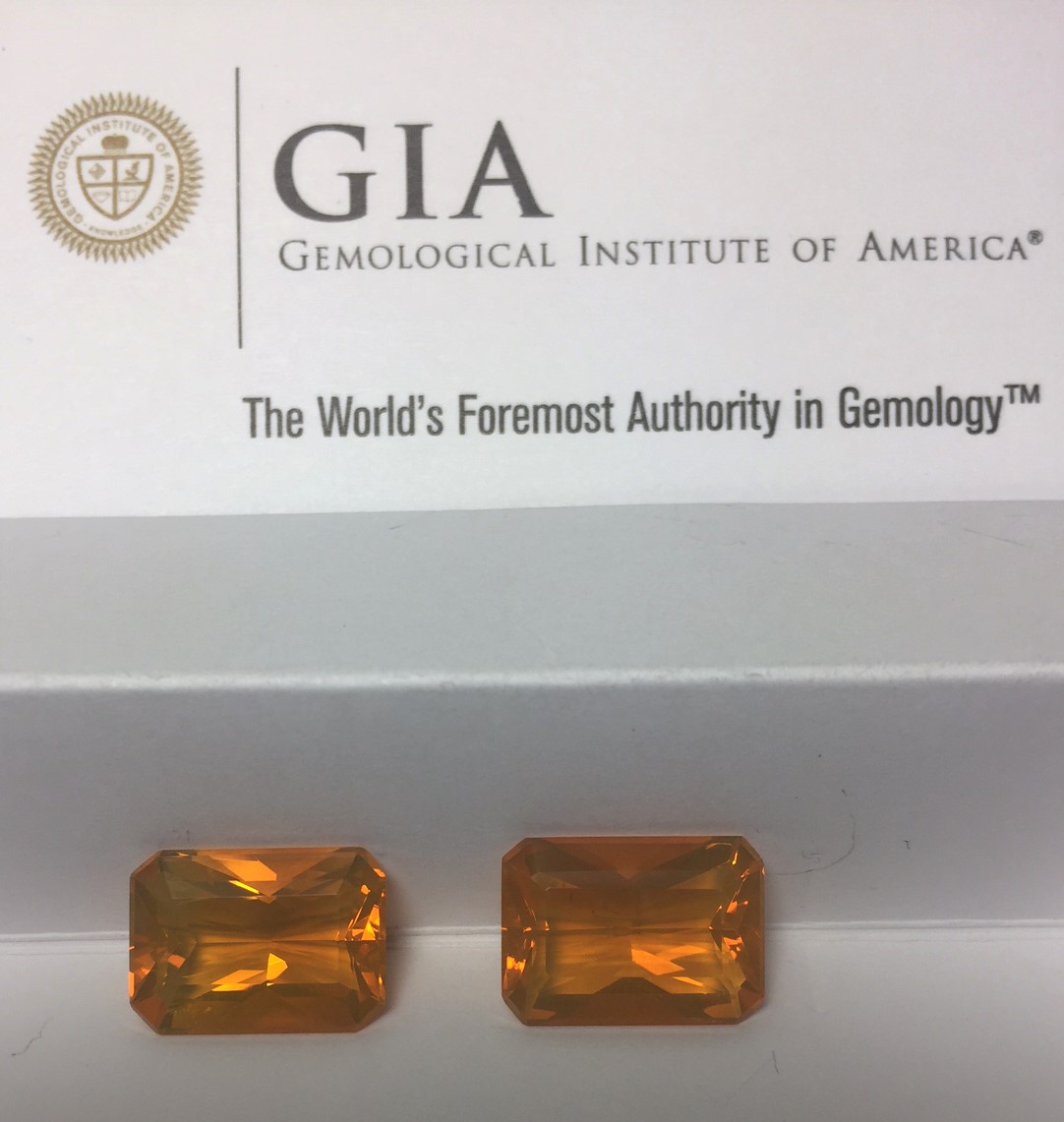
History and Lore
Opal’s name is believed to have originated in India, the source of the first opals brought to the Western world, where in Sanskrit it was called upala, or “precious stone." In ancient Rome, this became opalus.
Many cultures assigned supernatural origins and powers to opal. Ancient Bedouins, nomadic animal herders of Middle Eastern deserts, once believed opal fell from the heavens in flashes of lightning during thunderstorms. Ancient Greeks believed opal gave its owners the gift of prophecy and guarded them from disease. Considered a symbol of love, hope, fidelity, and purity, ancient Romans admired opal because it encompasses the colors of all other gems. The Roman scholar Pliny observed, “Some opali carry such a play within them that they equal the deepest and richest colors of painters. Others…simulate the flaming fire of burning sulphur and even the bright blaze of burning oil.” He marveled that this kaleidoscopic gem encompassed the red of ruby, the green of emerald, the yellow of topaz, the blue of sapphire, and the purple of amethyst.
Europeans long maintained opal was a symbol of hope, purity, and truth. At one time, it was thought to possess the power to preserve the life and color of blond hair.
Written in 1829, the novel Anne of Geierstein by Sir Walter Scott gave opal a reputation as being unlucky for anyone born in another month to wear it. That particular superstition did not originate from any ancient belief or experience, it was simply part of the novel’s story.
When Australia’s mines began to produce opals commercially in the 1890s, it quickly became the world’s primary opal source.
Fire opal has long been regarded as giving its wearer confidence, energy and joy.
Use in Jewelry Today
Opal gemstones come in a wide range of sizes and carat weights. Its relatively low density compared to other gemstones make it comfortable to wear even in larger sizes.
Precious opal, those displaying play-of-color, are the most prized of the opal family. Among precious opals, white opal is the most common variety with black opal the most treasured. A hierarchy of value exists among precious opals based upon play-of-color characteristics. The finest opals possess broad play-of-color patterns over the stone’s entire surface in which all the colors of the spectrum are represented. Not every precious opal, however, sparkles with every color of the rainbow. In some, the play-of-color consists of just one main color and two or more secondary colors.
Among common opals, fire opal is especially well-suited for earrings, where even small stones add a striking pop of color. The blazing red-orange color of Mexican fire opal is the perfect accent for earth tones and pairs well with bright hues. Crystal clear and intensely bright red is the most rare and valuable fire opal. Unlike most opal, fire opal is often faceted. Fire opal is relatively soft and should be set in a protective mounting. Like all opal, fire opal has a high water content and should be protected from intense heat and prolonged exposure to strong light.
Because it’s not a particularly hard gemstone, opal jewelry should be stored by itself to prevent pieces set with harder gems from scratching it. To learn more about caring for your fine jewelry, please read our blog Caring For Fine Gemstone Jewelry. The safest way to clean opal is with warm, soapy water. For more detail on cleaning opal jewelry, please read our blog Cleaning Fine Gemstone Jewelry. If an opal loses moisture, it can lead to crazing: a fine network of cracks that resembles a spider’s web. The moisture loss can be caused by heat or excessive dryness, or by exposure to bright light or direct sunlight.
Precious Opal Color Characteristics and Treatments
Since precious opal is by far the most desired of the opal family, this section will focus exclusively on them. Individual precious opals can vary widely in appearance and quality. As diverse as snowflakes or fingerprints, no two opals are exactly alike. The three main quality aspects of a precious opal are:
- Body Color Hues and Clarity
- Play-of-Color Hues
- Play-of-Color Pattern and Coverage
Body Color Hues and Clarity – Body color is caused by the suspension of tiny impurities within opal’s silica spheres. An opal’s clarity can range all the way from completely transparent to opaque. Experts expect different levels of clarity for different precious opal types. For example, in crystal opal, experts admire transparency, while in black opal they prefer an opaque background. In each case, the most desired background is that which best displays its play-of-color. A cloudy or milky background color lowers the value of any opal, because it makes the gem less attractive and can sometimes signal a lack of stability. Precious opal body color hues and clarity are discussed above in the introductory section of this blog.
Play-of-color Hues – Opal play-of-color can include any color of the rainbow. Precious opal is made up of uniformly sized, sub-microscopic spheres of silica stacked in an organized three dimensional grid-like pattern like layers of ping-pong balls in a box. The even spacing between the spheres allows white light waves travelling in the grid to diffract, creating play-of-color. The color you see varies with the sizes of the silica spheres grouped together in a particular area. Areas of spheres approximately 0.1 micron (one ten thousandth of a millimeter) in diameter produce violet. Spheres around 0.2 microns in diameter produce red. Sizes between 0.1 and 0.2 microns produce all the remaining colors. No two opals are exactly alike because the unique array of sections of silica spheres forms its own equally unique play-of-color pattern and color display. Red play-of-color has traditionally been considered most desirable, followed by orange and then green. However, favored colors can vary with fashion or personal preference. An opal can also display multiple colors.
NOTE: Common opals are also made up of silica particles. The reason common opal does not display play-of-color is the silica particles are of different shapes and sizes and randomly arranged. The resulting unevenly sized gaps between silica particles does not allow light to diffract. It is believed by scientists the difference in silica configurations between common and precious opal is caused by differences in water evaporation rates.
Play-of-Color Pattern – Not only does the color and number of colors displayed affect opal’s value; so does pattern and coverage of the play-of-color. Pattern describes the arrangement of an opal’s play-of-color. Like the shapes you see in the clouds, play-of-color takes many forms. Common terms for play-of-color patterns include:
- Pinfire or pinpoint - Small, closely set patches of color
- Harlequin or mosaic - Broad, angular, closely set patches of color
- Flame - Sweeping reddish bands or streaks that shoot across the stone
- Peacock - Mainly blue and green play-of-color
When evaluating pattern, buyers must also consider “dead spots”, an area of the gem where only body color is visible with no play-of-color. Dead spots detract from opal value, especially if there are several of them. In general, connoisseurs prefer large, closely arranged patches of color over tiny, scattered dots. Regardless of pattern, the brightness of the opal’s play-of-color is more important in determining the stone’s value.
An opal’s play-of-color can also be affected by its viewing angle or type of light. For example, red might dominate in the same area of an opal cabochon where blue dominates when it’s viewed from a different angle. The most valuable opals display play-of-color from all angles
Various clarity characteristics can negatively affect precious opal’s value. Like other gems, it might have fractures, pits or other surface blemishes. An opal might contain fragments of its host rock, called matrix. Matrix in a polished opal is usually, but not always, detrimental to appearance and value, depending on the type of opal.
Assembled Opals and Opal Treatments - Other than boulder and matrix opals, natural opal gemstones are solid with the gem material thick enough to withstand everyday jewelry wear and tear without breaking. Assembled opals are partially man-made stones, consisting of only a thin slice of natural opal cemented to solid backing material. Assembled opals might include materials like glass that aren’t normally part of gem-quality jewelry, but because they are partly precious opal still have value. They sell for only a fraction of the price of boulder opals, but they allow manufacturers to make attractive finished gems from thin opal pieces which might otherwise be wasted. The two common types of assembled opal are:
- Doublet - a thin layer of opal is cemented to a backing which can be made of obsidian, dyed black chalcedony, black glass, natural common opal, or plastic.
- Triplet - a thin layer of opal is cemented between a colorless domed top layer and a layer of backing material, as described for doublets. The top can be quartz, plastic, glass, or synthetic corundum which can magnify the color, protect the stone, and give it a cabochon (domed) appearance. Like doublets, the backing can consist of obsidian, chalcedony, black glass, etc.
Although opal is rarely enhanced by methods other than cutting and polishing, they may be treated to enhance their play-of-color. Two techniques used to accomplish this are sugar treatment and smoke treatment. In both cases, the opal must be fairly porous to successfully be treated. With sugar treatment, the opal is heated in a sugar solution and then immersed in concentrated sulfuric acid. This blackens the body color and intensifies its flashes of color. In smoke treatment, the opals are wrapped in paper and heated, which causes soot particles to penetrate the opal and likewise darkens the background color.
Opals can also be treated by impregnation with colorless oil, wax, resin, plastic, and hardeners to fill cracks, which improves appearance and durability. Occasionally, some thinner or translucent opal may be painted with a black epoxy on the backside of the gemstone to darken the gem and improve its play-of-color.
Synthetic opal – Synthetic opal is occasionally encountered in the trade. In the 1970s, the Gilson Company developed a three-step process to make a marketable synthetic opal. First, microscopic spheres of silica are created. Then, the man-made spheres settle in acidic water for more than a year. Finally, a hydrostatic press consolidates the spheres without distorting the stacked arrangement which creates opal’s play-of-color. Under magnification the synthetic opal can be identified by a honeycomb or snakeskin pattern.
Imitation opal – The “Slocum Stone” is an imitation opal made of glass, which uses tinsel-like flakes to create an effective, affordable, tougher and more durable alternative to natural opal. Opal imitations have also been made from clear plastic or epoxy resin with a colored tinsel acting as the play-of-fire. These imitations are virtually worthless and not very convincing to a trained eye.
Formation, Mining and Cutting
Today, while opal can be found in many places around the world, the primary sources are Australia, Mexico and the United States. To put it in perspective, though, Australia is by far the largest producer with an estimated 90% of the world’s supply. Opal is Australia’s national gemstone. Ethiopia, Brazil and Peru are also important sources.
Precious opal - is the product of strong seasonal rains that drenched dry ground in desert areas and regions such as Australia’s semi-desert outback which contained rocks rich in silica (a compound of silicon and oxygen). The rain water soaked deep into crevices in ancient underground rock, carrying dissolved silica in the cracks and between rock layers. During ensuing dry periods, much of the water evaporated, leaving solid deposits of silica in the form of tiny spheres in the cracks and between the layers of underground sedimentary rock. As this process repeated itself over millions of years, opal formed. Opal normally contains 3% to 10% water, with some types trapping up to 20% water in its silica structure.
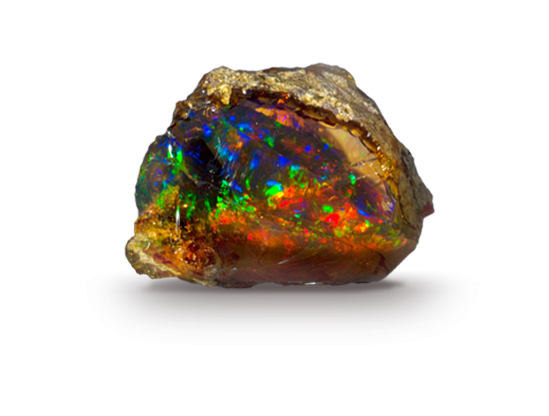
Photo Credit for Rough Opal to GIA
Lightning Ridge, a small town in New South Wales, Australia, is famed for producing prized black opals. A dry, rocky region with small trees and scrub brush, Lightning Ridge gets little rain and bakes in scorching summer temperatures. The climate is so unforgiving that miners often live underground to find relief from the punishing heat.
Australia is also a source of other types of opal. White opal is found in the White Cliffs area of New South Wales, as well as in Mintabie, Andamooka and Coober Pedy in South Australia. Boulder opal, which comes from only one location in the world, is mined in Queensland.
The US precious opal supply comes primarily from remote mountains and valleys in several western states. Black opal and common opal are the primary precious types produced in the US.
Opal cutters usually cut top-quality rough to show off its spectacular play-of-color. Most precious opals are not faceted but cut into rounded or free-form shaped cabochons that brings out as much of their natural play-of-color as possible.The cutter considers an opal’s color, pattern, and clarity when planning the finished gem. If it’s a cabochon, the dome should be well rounded. Domed surfaces give the best play-of-color, and make the stone appear vivid from most viewing angles. If the cabochon is flat, it might be vulnerable to breakage, especially when setting in jewelry. If it’s too high, it might be hard to set in jewelry.
On the other hand, cutters typically fashion commercial-quality white opal and assembled opal into standard calibrated sizes, usually ovals.
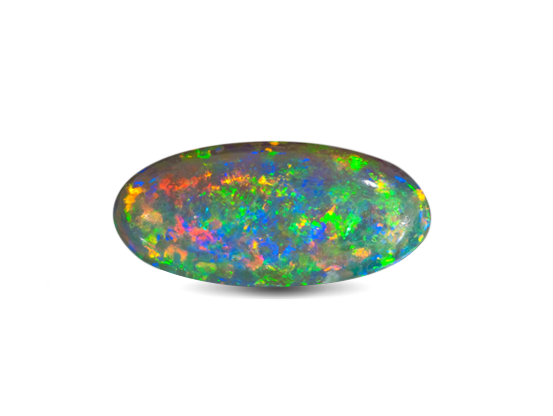
Photo Credit for Polished Opal to GIA
Fire opal - as its name suggests, is formed from the fires of ancient volcanoes. Water seeped into the silica-rich lava, filling seams and hollows. Under incredible heat and pressure, the trapped water formed fire opal. Mayan and Aztec cultures cherished this brightly colored gem, calling it “the stone of the bird of paradise.”
The most famous fire opals are from Mexico, whose most significant deposits were discovered in the state of Queretaro in 1835. They are still producing today as well as in other Mexican states, such as Hidalgo, Guerrero and Chihuahua. Today, attractive examples of fire opal come from Ethiopia, with a new promising find in Australia. Small quantities of can also be found in the US state of Oregon and British Columbia. The market favors Mexican material above all others, though.
Most fire opal material is cut into cabochons. However, transparent material, unlike most opal, is often faceted, allowing the stone to sparkle with brilliance.
Famous Opals
Some famous opals:
Recently, when attending an AGTA Tucson GemFair, the Smithsonian Institute had the below opal necklace designed by Louis Comfort Tiffany on display. The 18 kt yellow gold necklace, which was sold in 1929, features an Australian-mined black opal with blue and green play-of-color along with rare Russian demantoid garnets. The motif of vines and grape leaves is an excellent example of early 20th century Art Nouveau jewelry. Tiffany used opals extensively in his jewelry.
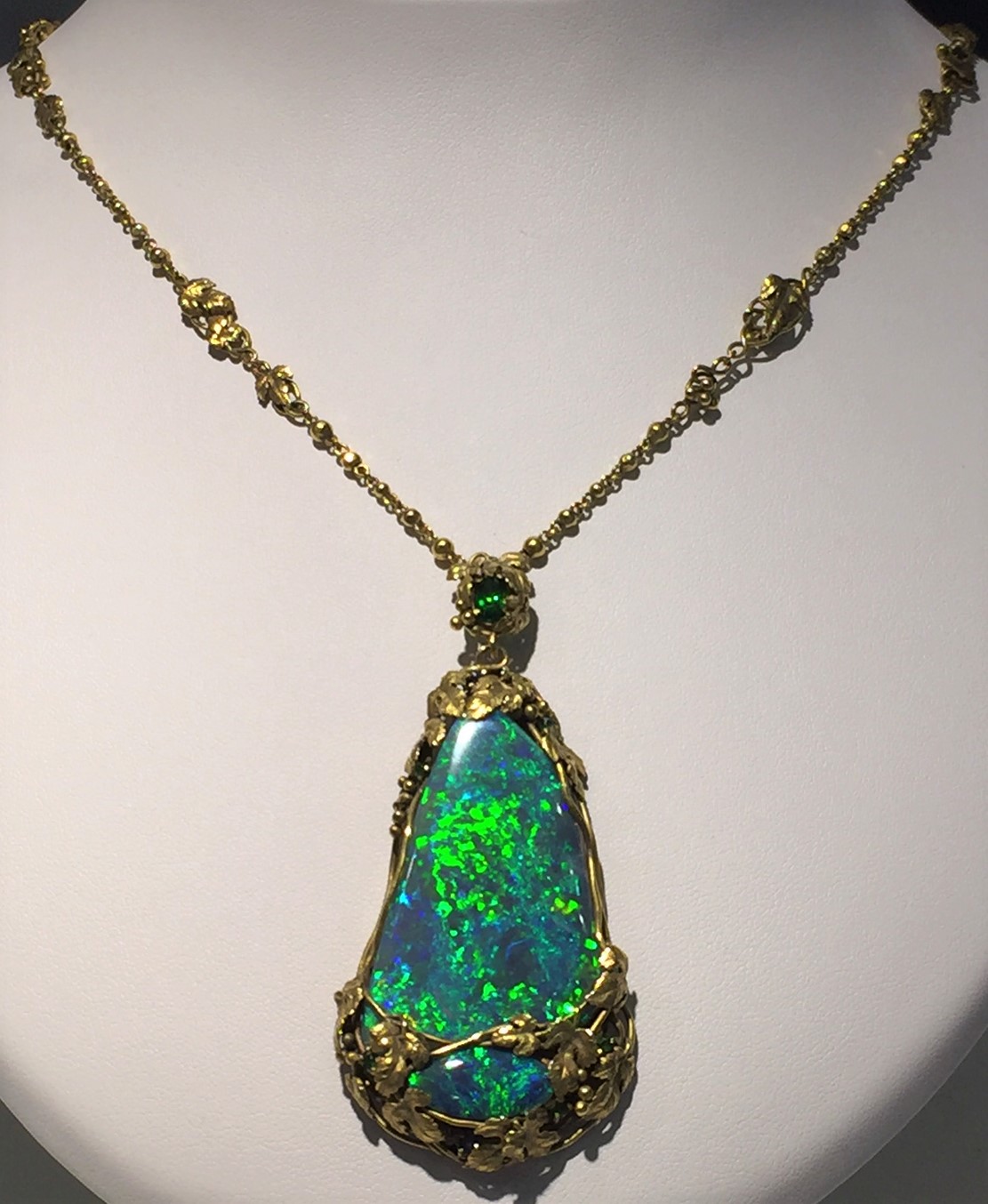
While at the same gem buying show, I took a couple cell phone pictures of 2 other impressive loose opal gemstones:
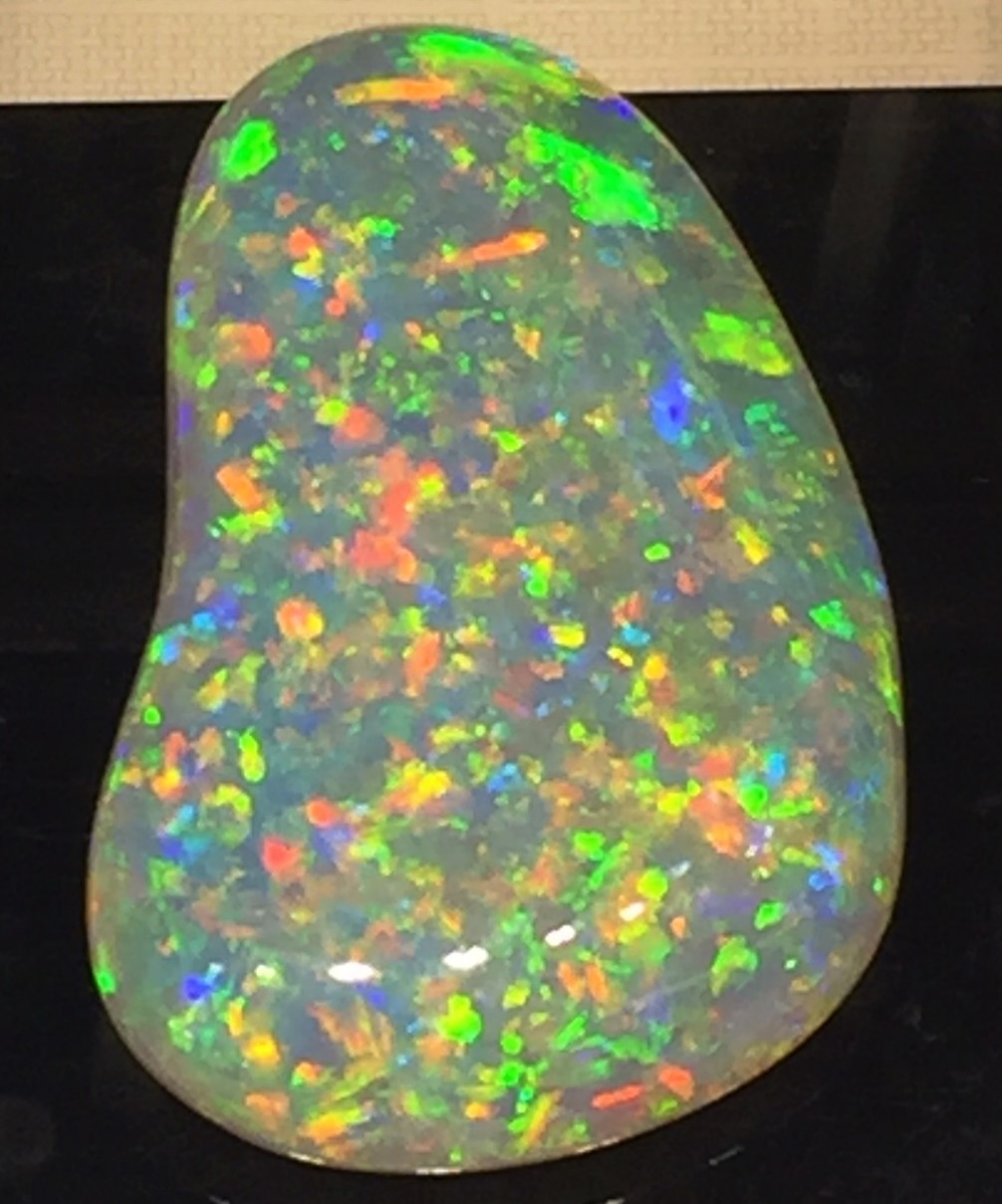
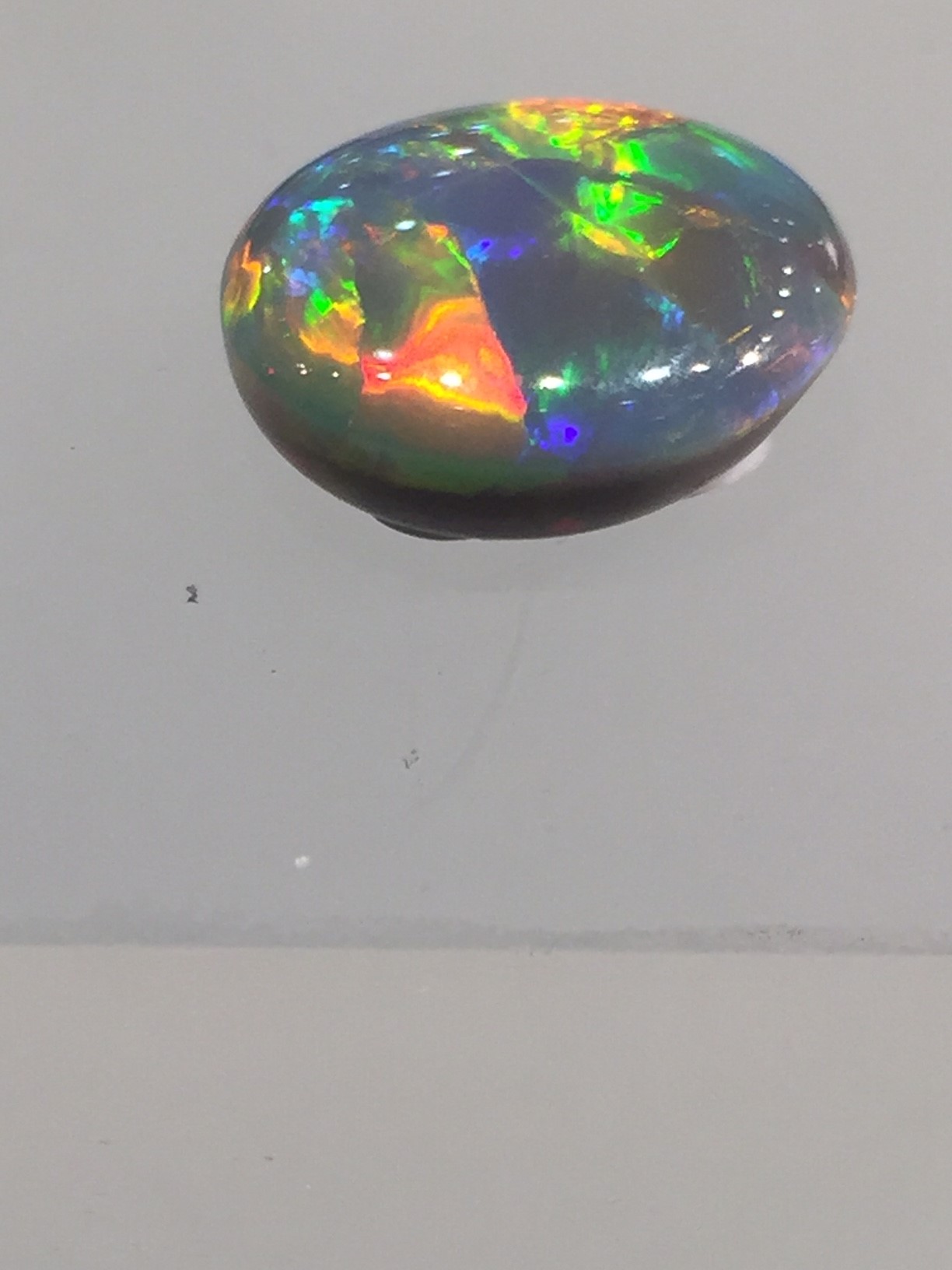
Some other famous opals:
Harry Winston’s Opal Peacock Brooch has a 32-carat black opal from Australia. It’s on display at the Smithsonian’s Museum of Natural History
The 2,585-ct. Roebling Opal is an extraordinary piece of opal rough from Virgin Valley, Nevada. The gem is in the collection of the Smithsonian National Museum of Natural History.
The 17,000-carat 11-inch long Olympic Australis opal rough, was found in 1956 in Australia. It’s on permanent display at Altmann & Cherny - Opal Specialists in Melbourne, Australia.
Credit American Gem Trade Association, Gemworld International and Gemological Institute of America for contributing to the above information.

